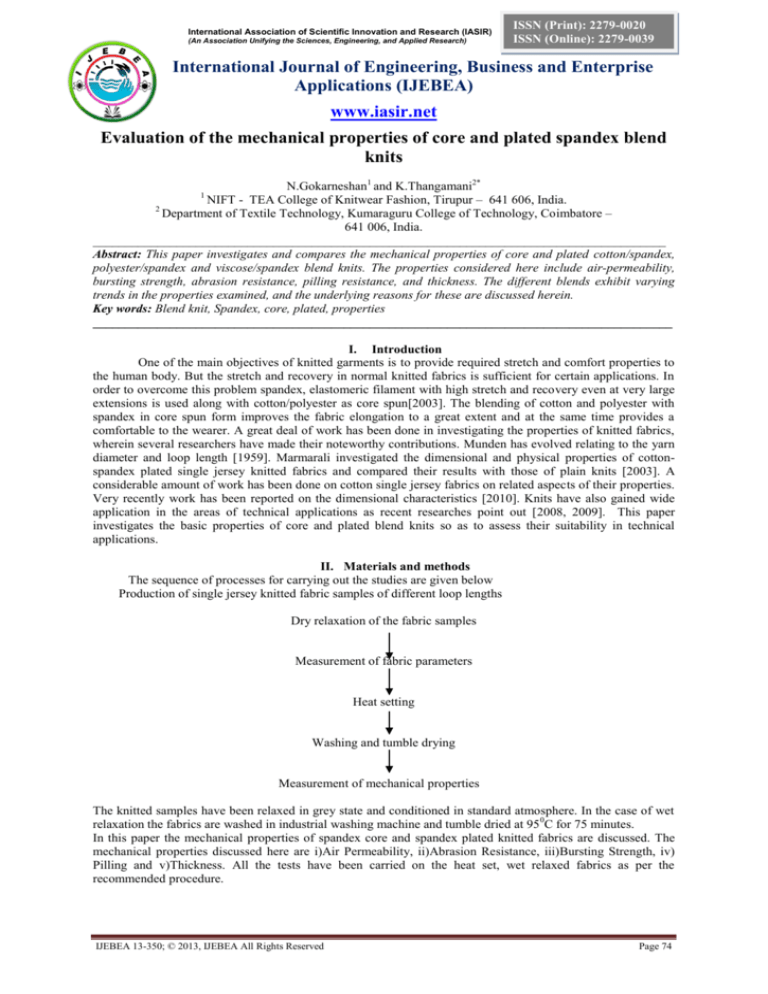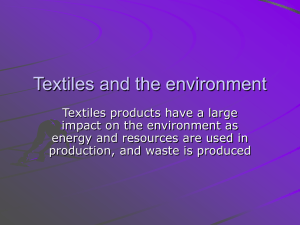
International Association of Scientific Innovation and Research (IASIR)
(An Association Unifying the Sciences, Engineering, and Applied Research)
ISSN (Print): 2279-0020
ISSN (Online): 2279-0039
International Journal of Engineering, Business and Enterprise
Applications (IJEBEA)
www.iasir.net
Evaluation of the mechanical properties of core and plated spandex blend
knits
N.Gokarneshan1 and K.Thangamani2*
NIFT - TEA College of Knitwear Fashion, Tirupur – 641 606, India.
2
Department of Textile Technology, Kumaraguru College of Technology, Coimbatore –
641 006, India.
_________________________________________________________________________________________
Abstract: This paper investigates and compares the mechanical properties of core and plated cotton/spandex,
polyester/spandex and viscose/spandex blend knits. The properties considered here include air-permeability,
bursting strength, abrasion resistance, pilling resistance, and thickness. The different blends exhibit varying
trends in the properties examined, and the underlying reasons for these are discussed herein.
Key words: Blend knit, Spandex, core, plated, properties
__________________________________________________________________________________________
1
I. Introduction
One of the main objectives of knitted garments is to provide required stretch and comfort properties to
the human body. But the stretch and recovery in normal knitted fabrics is sufficient for certain applications. In
order to overcome this problem spandex, elastomeric filament with high stretch and recovery even at very large
extensions is used along with cotton/polyester as core spun[2003]. The blending of cotton and polyester with
spandex in core spun form improves the fabric elongation to a great extent and at the same time provides a
comfortable to the wearer. A great deal of work has been done in investigating the properties of knitted fabrics,
wherein several researchers have made their noteworthy contributions. Munden has evolved relating to the yarn
diameter and loop length [1959]. Marmarali investigated the dimensional and physical properties of cottonspandex plated single jersey knitted fabrics and compared their results with those of plain knits [2003]. A
considerable amount of work has been done on cotton single jersey fabrics on related aspects of their properties.
Very recently work has been reported on the dimensional characteristics [2010]. Knits have also gained wide
application in the areas of technical applications as recent researches point out [2008, 2009]. This paper
investigates the basic properties of core and plated blend knits so as to assess their suitability in technical
applications.
II. Materials and methods
The sequence of processes for carrying out the studies are given below
Production of single jersey knitted fabric samples of different loop lengths
Dry relaxation of the fabric samples
Measurement of fabric parameters
Heat setting
Washing and tumble drying
Measurement of mechanical properties
The knitted samples have been relaxed in grey state and conditioned in standard atmosphere. In the case of wet
relaxation the fabrics are washed in industrial washing machine and tumble dried at 95 0C for 75 minutes.
In this paper the mechanical properties of spandex core and spandex plated knitted fabrics are discussed. The
mechanical properties discussed here are i)Air Permeability, ii)Abrasion Resistance, iii)Bursting Strength, iv)
Pilling and v)Thickness. All the tests have been carried on the heat set, wet relaxed fabrics as per the
recommended procedure.
IJEBEA 13-350; © 2013, IJEBEA All Rights Reserved
Page 74
K.Thangamani et al., International Journal of Engineering, Business and Enterprise Applications, 6(1), September-November., 2013, pp. 7478
The measurement of air permeability is based on the rate of flow of air through a given area of fabric by giving
a pressure drop across the fabric (IS:11056-1984). Martindale abrasion tester is used to measure the abrasion
resistance, which is based on constant revolution method as per ISO 12947-2. The Bursting strength is
determined using hydraulic diaphragm bursting tester as per ISO 13938-1. The pilling grade is evaluated using
grade scale with specific ratings adopting the ISO – 12945 – Section – 1:2000 standard. The fabric thickness is
measured using the ISO 5084 and ASTM 1777-96 standards.
III. Results and discussion
A. Measurement of air-Permeability
The air permeability values of cotton/spandex and polyester/spandex plain knitted fabric and for
viscose/spandex plated plain knitted fabrics have been measured. It can be observed that air permeability values
of 15tex and 20tex cotton / spandex and 170d and 97d polyester/spandex plain knitted fabrics does not change
in a significant manner with the loop length .
Another observation that can be made is that finer the yarn lesser is the air permeability (fig1).When the yarn is
finer the air gaps within the yarn and between the yarn is reduced and hence the air permeability also is reduced.
AIR PERMEABILITY
Air permeability cm³/cm²/s
100
80
15te
x20te
x170
d97d
60
40
20
0
10
12
14
16
18
Tightness factor
Fig. 1 Air permeability of cotton/spandex and polyester /spandex plain knitted fabrics
Air permeability
(cm³/cm²/s)
VSP-AIR PERMEABILITY
140
120
100
80
60
40
20
0
No plating
Half plated
Full plated
14
14.5
15
15.5
16
16.5
17
Tightness factor
Fig. 2 Air permeability of viscose/spandex plated plain knitted fabrics
In the case of full plated fabrics the air permeability is drastically less compared to half plated and 100% viscose
fabric. As the spandex content is more the fabric becomes tighter and hence less air permeability. Within the
same spandex content the air permeability increases with increase in loop length or decrease in tightness
factor.(fig.2)
B. Abrasion Resistance
The abrasion resistance of 15tex and 20tex cotton/spandex plain knitted fabrics and for viscose /spandex plated
fabrics have been measured. The abrasion resistance is plotted against tightness factor.
It can be observed that under normal testing conditions the abrasion resistance of 15tex and 20tex fabric it
remains more on less constant at 99%. The abrasion resistance of 170d and 97d polyester /spandex fabrics is
almost 100%.(fig.3)
As in the case of cotton / spandex and polyester / spandex fabrics the viscose/ spandex plated fabrics also show
high abrasion resistance (fig.4). The abrasion resistance for half plated fabric is around 97% and for full plated
fabric is around 99%. Here a slight decrease in abrasion resistance for increase in loop length can be observed.
IJEBEA 13-350; © 2013, IJEBEA All Rights Reserved
Page 75
K.Thangamani et al., International Journal of Engineering, Business and Enterprise Applications, 6(1), September-November., 2013, pp. 7478
105
100
20tex
95
15tex
90
170d
97d
85
16
14
.7
13
.3
12
.5
11
.4
10
.7
17
80
16
.9
15
.4
14
.5
14
.2
12
.9
11
.9
Abrasion resistance (%)
ABRASION RESISTANCE
Tightness factor
Fig. 3 Abrasion resistance of cotton/spandex and polyester/spandexplain knitted fabrics
VSP-ABRATION RESISTANCE
Abration resistance %
100
98
96
No plating
94
Half plated
92
Full plated
90
88
16.5 15.4 14.4 16.5 15.4 14.4 16.5 15.4 14.4
Tightness factor
Fig. 4 Abrasion resistance of viscose/spandex plated plain knitted fabrics
C. Bursting strength
The bursting strength of cotton / spandex knitted and polyester/spandex fabric have been determined. It has been
observed that the bursting strength is lower for 15tex fabric than for 20tex fabrics which is obvious due to the
higher single yarn strength for 20tex. In both cases the bursting strength decreases with decreases in tightness
factor. As the tightness factor decreases the fabric becomes loose, hence bursting strength also is lower. The
bursting strength of 170d fabrics are higher than the 97d fabrics and it slightly decreases with tightness factor.
However, the decrease in bursting strength with tightness factor in 97d fabrics is marked. In fig. 5 and fig. 6 the
bursting strength of cotton /spandex and polyester/spandex fabrics are shown.
Bursting strength (kg/cm²)
BURSTING STRENGTH
14
12
10
20tex
8
15tex
6
170d
4
97d
2
10.7
11.4
12.5
13.3
14.7
16
17
11.9
12.9
14.2
14.5
15.4
16.9
0
Tightness factor
Fig. 5 Bursting strength of cotton /spandex and polyester /spandex plainknitted fabrics
Bursting strength (kg/cm²)
VSP-BURSTING STRENGTH
6
5
4
No plating
3
Half plated
2
Full plated
1
0
16.5 15.4 14.4 16.5 15.4 14.4 16.5 15.4 14.4
Tightness factor
Fig. 6 Bursting strength of viscose/spandex plated plain knitted fabrics
IJEBEA 13-350; © 2013, IJEBEA All Rights Reserved
Page 76
K.Thangamani et al., International Journal of Engineering, Business and Enterprise Applications, 6(1), September-November., 2013, pp. 7478
In viscose plated fabrics bursting strength increases with increase in plating level. The bursting strength for half
plated fabrics is between 3.5 to 3.85 kg /cm2. And for full plated fabrics it is between 4.5 to 5.0 kg / cm2. Within
the same spandex content the bursting strength decreases with increase in loop length.
D. Pilling
The pilling grades of cotton/spandex and polyester/spandex knitted fabrics are given in Figure 7
It can be observed from the fig.7 that the pilling grades of 15tex fabrics are poor in all the cases. The pilling
grades of 20tex fabrics are good for higher tightness factors of 16.9 and 15.4 and medium for lower tightness
factor of 14.5. Therefore, we can conclude that for a good pilling grade the tightness factor should be above
15.4. The pilling grades of cotton/spandex fabrics are given. in fig 8.
CS-PILLING
5
Pilling grade
4
3
15tex
2
20tex
1
0
14.2
12.9
11.9
16.9
15.4
14.5
Tightness factor
Fig. 7 Pilling grades of cotton/spandex plain knitted fabrics
PS-PILLING
5
Pilling grade
4
3
170d
2
97d
1
0
17
16
14.7
13.3
12.5
11.4
10.7
Tightness factor
Fig. 8 Pilling grades of polyester/spandex plain knitted fabrics
VSP-PILLING
5
Pilling grade
4
No plating
3
Half plated
2
Full plated
1
0
16.5
15.4
14.4
16.5
15.4
14.4
16.5
15.4
14.4
Tightness factor
Fig. 9 Pilling grades of viscose/spandex plated plain knitted fabrics
The pilling grades of 170d and 97d polyester /spandex knitted fabrics are very good for all the tightness factors
because the polyester is in filament form. The pilling grades for polyester/spandex fabric are given in fig. 9
The pilling grades of viscose /spandex plated knitted fabrics have been assessed. For viscose /spandex plated
knitted fabrics the plating level increases the pilling grade. The pilling grade is 1-2 for fabrics without plating, 23 for half plated fabrics and 3-4 for full plated fabrics.
E. Thickness
The thickness of 15tex and 20tex cotton / spandex fabric and 170d and 97d polyester/spandex fabrics for various
tightness factor have been determined. It has been observed that for 15tex and 20 tex cotton / spandex fabrics as
the tightness factor increases the structure becomes compact and as a result the thickness decreases.
The thickness of 170d and 97d polyester/spandex fabrics also the thickness decrease as the tightness factor
increases. This may be due to the reason that as the fabric becomes tighter it becomes more compact resulting in
reduction in thickness. In fig.10 thickness of cotton/spandex and polyester /spandex fabrics have been plotted
against tightness factor.
For viscose /spandex plated fabrics the fabric thickness for various loop lengths and plating levels have been
measured. It has been observed that the fabric thickness is highest for full plated fabrics followed by half plated
IJEBEA 13-350; © 2013, IJEBEA All Rights Reserved
Page 77
K.Thangamani et al., International Journal of Engineering, Business and Enterprise Applications, 6(1), September-November., 2013, pp. 7478
fabrics and least for 100% viscose. It can also been seen that the fabric thickness increases with loop length.
Figure 11 shows the fabric thickness for viscose plated fabrics. The fabric thickness is more at higher loop
lengths due to the bulky effect of the fabric at higher loop length. As the tightness factor increases the thickness
decreases.
1.6
1.4
1.2
1
0.8
0.6
0.4
0.2
0
20tex
15tex
170d
16
14
.7
13
.3
12
.5
11
.4
10
.7
17
97d
16
.9
15
.4
14
.5
14
.2
12
.9
11
.9
Thichness(mm)
THICKNESS
Tightness factor
Fig. 10 Thickness of cotton/spandex and polyester /spandex Plain knitted fabrics
VSP-THICKNESS
Thickness(mm)
1
0.8
No plating
0.6
Half plated
0.4
Full plated
0.2
0
14
14.5
15
15.5
16
16.5
17
Tightness factor
i)
ii)
iii)
iv)
v)
Fig. 11 Thickness of viscose /spandex plated plain knitted fabrics
IV. Conclusion
Air permeability remain constant irrespective of count and loop length for cotton/spandex fabrics where as
it decreases with increase in loop length for 97d polyester /spandex fabrics. For viscose /spandex plated
plain knitted fabrics air permeability is influenced by spandex content and loop length. It decreases with
increase with spandex content and increases with loop length
Abrasion resistance for cotton/spandex and polyester /spandex fabrics are good at nearly 99-100% .For
viscose /spandex plated knitted fabrics increase in plating level increases the abrasion resistance.
Bursting strength of cotton/spandex fabrics decrease with loop length and course count fabrics have more
bursting strength. The bursting strength of polyester /spandex fabrics are more than that in viscose
/spandex plated knitted fabrics the and plating level increases the bursting strength.
The pilling grade of cotton /spandex fabrics are poor where as the pilling grade of polyester /spandex
fabrics are good. The increase in spandex content in viscose /spandex plated fabrics improves the pilling
grade.
The thickness of both cotton /spandex and polyester /spandex fabrics decreases with increase in tightness
factor. For viscose /spandex plated knitted fabrics the thickness increases with increase in spandex content.
REFERENCES
1.
2.
3.
4.
5.
6.
Bhuvanesh G & Nilesh R 2009, “Development and structural evaluation of PLA based knitted scaffold for human urinary bladder
reconstruction”, Indian journal of fibres and textile research, Vol.34,., 115-121.
Gokarneshan N, & Thangamani K 2010, An investigation into the properties of
cotton/spandex and polyester/spandex knitted
fabrics, Journal of the textile institute, Vol.101, No.2, 182.
Kirk W M Jr. 1963, “Lycra Spandex fibre-structure and properties” American dyestuff reporter, 725-727.
Marmarali AB 2003, Dimensional and physical properties of cotton/spandex single jersey fabrics, Textile research journal, 73(1),
11.
Munden DL 1959, The geometry and dimensional properties of plain knit fabrics, Journal of the Textile Institute, 50, 448 – 471,.
Anand S 2008, Designer natural fibre geotextile – A new concept, Indian journal of fibre and textile research, Vol.33, 339-344.
IJEBEA 13-350; © 2013, IJEBEA All Rights Reserved
Page 78









